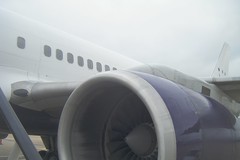 Jet Suffered Two-Foot Hole, Decompression
Jet Suffered Two-Foot Hole, Decompression 10/28/2010
By ANDY PASZTOR
Boeing Co. and federal air-safety officials are stepping up scrutiny of certain Boeing 757 aircraft after a two-foot hole opened earlier this week in the fuselage of an American Airlines jet cruising at 31,000 feet, resulting in rapid cabin decompression.
The emergency, which occurred on an AMR Corp. American Airlines jet en route from Miami to Boston on Tuesday, prompted the crew and 154 passengers to don oxygen masks about half an hour into the flight. The twin-engine 757 descended to a lower altitude, turned around and made a safe landing at Miami International Airport. There were no injuries.
But industry officials said the incident—which created a rupture roughly two feet long and a foot wide above the jet's front left cabin door—bears some similarity to cracks found last month in the fuselage of a United Continental Holdings' United Airlines Boeing 757.
According to industry officials, manufacturer Boeing working on a safety alert, called a service bulletin, dealing with stepped-up inspections of certain portions of older 757 models. Industry officials said both planes had logged between 20,000 and 25,000 flights, which would make them middle-aged aircraft. Enhanced-inspection programs often apply to older planes that have undergone greater structural stress from many more takeoffs and landings. Rapid cabin decompressions are rare events, and they may stem from undetected metal fatigue that can suddenly peel back a portion of an aircraft's aluminum skin in midair.
It's too early to tell what caused the rupture on the American Airlines plane. Both the Federal Aviation Administration and the National Transportation Safety Board are investigating, but agency officials on Thursday declined to comment on their focus. Investigators, though, are looking for links between Tuesday's event and the damage found earlier on the United jetliner.
A Boeing spokeswoman declined to comment, except to say the company is providing technical assistance to the safety board and "will take appropriate action" as warranted by the investigation.
The American plane is out of service. Its flight-data and cockpit voice recorders have been shipped to the safety board, which also will examine the ruptured portion of the fuselage.
A spokesman for American Airlines confirmed details of the incident Thursday, adding that airline engineers and technicians are cooperating with government safety officials to determine the cause.
Based on initial reports, the spokesman said, the pressure loss inside the cabin started "with a small hole in the fuselage just above the first door on the left side" of the plane behind the cockpit, and then ripped open a gash two feet long.
American operates a fleet of more than 100 Boeing 757s on domestic and transcontinental routes, as well as to serve some international destinations. Hundreds of others are flown by major U.S. carriers, and 757s are widely used by large international carriers. Whatever stepped-up inspection procedures Boeing ultimately distributes will apply world-wide. But because such maintenance bulletins are only recommendations and aren't binding on carriers, U.S. and foreign air-safety regulators typically follow up with mandatory directives.
This week's incident caught the attention of investigators partly because the American jet isn't particularly old, and it doesn't fall into the category of ageing aircraft prone to metal fatigue and therefore already subjected to heightened scrutiny and structural inspections.
The cause of the latest in-flight rupture, according to industry officials, appears to have some parallels to a July 2009 incident involving a Southwest Airlines Co. Boeing 737 jet that made an emergency landing in Charleston, W.Va., after developing a one-foot hole on top of its fuselage at 30,000 feet. In that incident, the cabin rapidly lost air pressure, oxygen masks deployed and the plane diverted and made an emergency landing without any injuries.
Boeing subsequently urged operators of more than 130 older 737 jets to step up inspections or install certain strengthening metal parts around suspect areas. In January, the FAA ordered enhanced structural checks—repeated roughly every few months—of affected aircraft without the modifications. The agency said undetected cracks "could result in sudden fracture and failure of the fuselage skin panels, and consequent rapid decompression."
Write to Andy Pasztor at andy.pasztor@wsj.com

No comments:
Post a Comment